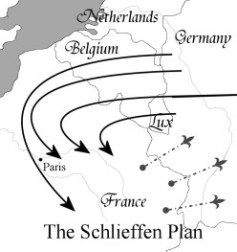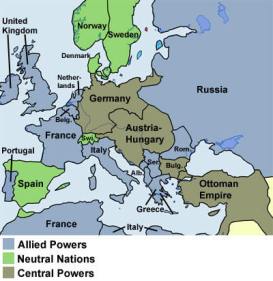University of Birmingham Graduate Zoë Vince on War Studies at Birmingham.
– What are the main advantages of a degree in War Studies? How would you try to convince someone considering this option?
War Studies is an extremely diverse, engaging and highly flexible subject to study at undergraduate level, offering a range of thematic and detailed modular options throughout three years of study. I would recommend that anyone interested in the subjects of politics, sociology and history and their respective links to either past or present conflicts should consider the merits of a War Studies qualification. I would also urge those interested in such a path to thoroughly research the alternative War Studies programmes in other universities than Birmingham, such as King’s College London (KCL), because each programme, due to institutional tradition, preferences and teaching staff, offers a different focus on the study of warfare.
Studying for a War Studies degree facilitates the development of sought-after transferable skills, as traditionally found with subjects such as history and English. More than this, however, War Studies offers the opportunity to study a multidisciplinary subject, demonstrating to prospective employers a willingness to engage with diverse material and develop a broad, not merely detailed, knowledge base. War Studies is a ‘stand-out’ degree; unlike more common subjects, answering the question “what did/do you study?” with “War Studies” will always be greeted with genuine interest. Finally, I would posit that War Studies is a genuinely enjoyable subject and is always interesting and challenging.
– What are the differences and similarities with a history degree?
The War Studies department at the University of Birmingham is based in the School of History and Cultures, whereas KCL’s is part of the School of Social Science and Public Policy, meaning that Birmingham’s programme is more, although not exclusively, centred on historical conflicts. The modular course structure affords a significant degree of flexibility, which results in War Studies and history students attending many of the same classes, depending on individual interests. Indeed, I have found that many history students, having been unaware of the opportunity to study War Studies, have come to prefer War Studies-led modules and even express regret that they chose single honours history.
The main difference between War Studies and history at Birmingham is the core War Studies modules, of which there is one in first and third year, and two in second year. These modules are: War, Armed Forces and Society (1st year), Strategy and Operational Art, Rise of Modern Warfare (2nd year) and Writing the History of Warfare (3rd year). These War Studies modules cover many multifaceted topics, concerning conflicts from the ancient world up to the present.
By way of assessment, students are permitted to choose their preferred essay questions, allowing independent research into a topic of interest. For example, I chose such subjects as Thucydides’ continued influence amongst Anglo-American historians and political scientists, the reasons behind Frederick the Great’s operational successes, and a comparative study of Blitzkrieg and Deep Battle theory. Students then build on this by choosing more specific, elective modules, which are also attended by history students; some, however, believe that going back into a mixed class can dilute the quality of debate, the War Studies students having had the benefit of specialist teaching.
In short, history and War Studies at Birmingham are closely linked, but War Studies students will fiercely argue that they are presented with the opportunity to become truly knowledgeable in a broad field, compared with the history student’s command of often a (relatively) short period.
– What general skills, not directly related to the subject but in demand in the labour market, are best developed by students in this area?
As previously mentioned, War Studies students develop all of the best traits of those reading Arts degrees. Employers commonly require evidence of verbal and written communication skills, presentation skills and independent research skills. Time management, organisational skills and analytical skills are equally sought after. Reading for Arts degrees, which have notoriously short contact hours and a high level of independence, and which require a series of long and detailed assessments, therefore provides students with an excellent foundation of skills for later employment.
With regards to War Studies specifically, there is a focus on subjects related to decision making and leadership, and the exploration of organisational structures and operational successes which can easily be applied to the workplace, our graduates having more of a detailed grasp on logical processes and the requirements of a successful organisation. This would translate well to employers, in comparison with a history degree which largely addresses themes and theories.
–What do War Studies graduates usually do after their first degree?
A large proportion of War Studies graduates go on to further study. Some choose to complete Law conversion courses, while a small number go on to train as teachers. Many apply to read conflict related postgraduate degrees, either at Birmingham in areas such as the world wars or religious warfare, or at KCL, for example, where more contemporary, policy based MAs and PhDs can be studied.
For those continuing directly into employment there are a wide variety of paths to consider. Public service is a popular choice, with graduates working for the Civil Service FastStream, the management training programme, or research and development organisations such as MoD trading fund Dstl. Some graduates prefer literary careers, working for think tanks or journals as writers or researchers, or for publishing and editing companies; some of our undergraduates have completed internships with a locally based military book publisher, for example. Legal careers at lower levels also appeal to some, and additionally we have graduates in areas such as social media, demonstrating the diversity of the degree.
As might be expected, a large percentage of War Studies graduates go on to successful careers in the Armed Forces, particularly the Army, for which Birmingham has a highly commended Officer Training Corps. Generally speaking, academic and military careers are the most popular for our graduates.
– Do you expect the coming centenary of the First World War to prompt more interest among students in applying for such degrees?
I am not sure if school-leavers will be more likely to choose War Studies, as many of our undergraduates are attracted to the broader phenomenon of war, rather than a specific conflict. There may well be a surge in interest for universities which offer courses related to the subject, but this has to be weighed up with the hugely rising cost of undergraduate degrees and the relative merits of Arts degrees compared to their scientific and technical counterparts.
I do think, however, that the centenary will have a positive impact on those pursuing further study, or returning to study, by taking advantage of Birmingham’s specialism in the First World War and our excellent teaching staff, and undertaking a postgraduate qualification, at master’s or doctoral level. It must be noted though, that the public perception of the First World War, which is likely to be enhanced by the government’s programme for commemorating the centenary, is noticeably incompatible with the university’s programme of revisionist study. It is for this reason that I think that Birmingham will continue to attract only those genuinely interested in the thorough, detailed study of the conflict.
– What are the main strengths of Birmingham University in this area?
The University of Birmingham contains the highly regarded Centre for First World War Studies, founded by Dr John Bourne, which has benefited from the teachings of Gary Sheffield, Jonathan Boff, Spencer Jones, Maj. Gen. David Zabecki (U.S. Army, ret.), Pierre Purseigle and the late Bob Bushaway. These scholars and others have contributed a huge amount of research into a range of aspects of the Great War, which have been largely characterised by the revisionist ‘side’ of the debate over ‘Lions led by Donkeys’. Birmingham can certainly offer those interested in studying the First World War a thoroughly enjoyable and highly regarded qualification in the subject. The current First World War Studies Master’s degree is a part time course, taught through monthly Saturday schools across two years, and is therefore greatly suited those fascinated by the subject but unable to commit to full time study.
– How does the War Studies Society at Birmingham contribute to students’ learning?
The War Studies Society, founded by undergraduate students in 2009, largely served as an undergraduate social group and mediating body between students and staff, concerning academic matters, until late 2011. Since then, the Society has embraced postgraduate students and broadened its focus to include careers opportunities and community work. I would say that the Society contributes to students’ learning by offering students from all levels opportunities to interact and discuss their work, encouraging debate and a reinforcement of material learned through formal academic study. Some postgraduates in particular, having been out of academia for a sometimes significant number of years, find it useful to discuss their methods and techniques for assessment with younger students. Fostering this community of likeminded individuals really aids the learning process and also builds friendships and networking links.
Could you tell us a bit about some of the events and activities which the Society organised last year?
Last year we organised a range of activities, including social events like day trips, notably to Bletchley Park, as well as meals, pub crawls and quizzes. A particular success has been the monthly postgraduate dinner, which gives the master’s students an opportunity, after their monthly day school, to socialise with undergraduates and occasionally professors.
In late November 2012 the Society held its first fundraising event, which raised £320 for the Armed Forces’ wing at the Queen Elizabeth Hospital, Birmingham. The event involved a First World War-themed football match, emulating the Christmas 1914 truce between British and German soldiers. All participants dressed up and there was a fantastic raffle, talks by the Western Front Association, authentic Edwardian cakes and period music by a live brass band.
Another first was the careers event held in Spring 2012, which hosted presentations from Jaguar Land Rover armoured vehicles, the Defence Science and Technology Laboratory (Dstl), Helion military publishers and RUSI journal, as well as speakers with information about Law conversions, War Studies postgraduate courses and Birmingham’s accredited employability course.
–Which one was your favourite?
My favourite was definitely the careers event, which I presented myself to over forty undergraduates. Given that there are only 75 War Studies undergraduates in total, and that a percentage already have a career in mind, this was a very good turn-out. A common complaint within the department is that information about related careers is scarce, with any History and Cultures careers events focusing on the heritage sector and academic pathways. The War Studies Society thus filled a gap in the market, so to speak, by holding this event, and provided much desired information to students who were unaware that War Studies can be applicable to so many diverse careers. I was particularly pleased to see students talking with the representatives, some signing up for internships, and even the representatives themselves exchanging details. I am hoping that this careers focus will be continued, as it is clearly sought after by undergraduates.
Interview by Alex Calvo, WWII MA student at Birmingham University




























